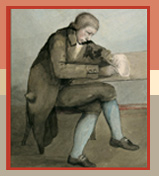
Iolo's Life
Autobiographical material (NLW 21387E)
The Agricultural Observer and Farmer
The Letter Writer
From 1770 until his death in 1826 Iolo was a regular correspondent and about 1400 letters survive in his archive, about a third of which (some 430 letters) are in his own hand. The majority of the letters are written in English, and only about 6% are in Welsh or contain an element of Welsh. On the whole, these Welsh letters belong to the 1770s and 1780s when Iolo was in touch with the poets of Glamorgan and members of the London-based Gwyneddigion Society. This exciting period in his bardic apprenticeship is perfectly encapsulated by the Welsh letters from Siencin Morgan of Llantrisant in 1771 and Owen Jones (Owain Myfyr) of London, in 1782.
Because of the sheer volume of letters that were circulated both privately and publicly in printed volumes and magazines, the historian Jürgen Habermas has characterized the eighteenth century as 'the century of the letter'. The letter could be used to disseminate a message effectively, and so its influence and economic value were considerable. Iolo was aware of this. He made numerous contributions to the periodical press in both Welsh and English and towards the end of his life he even dreamed of seeing a selection of his own letters appear in print.
Iolo Morganwg's letters are kept in six substantial volumes in the National Library of Wales: NLW 21280E-21286E. Additional letters are also kept in other collections housed at various locations: the National Library of Wales, Cardiff Central Library, Glamorgan Record Office, the British Library, the Bodleian Library Oxford and the National Record Office. The following magazines also include letters in his hand: The Cambrian, The Cambrian Register, Yr Eurgrawn Wesleyaidd, The Gentleman's Magazine and Seren Gomer.
Like the Morris and Trevecka correspondences, Iolo Morganwg's letters are among the most valuable resources for students of the cultural history of eighteenth-century Wales. But the range of subjects discussed in his letters and the sheer diversity of the people he corresponded with mean that Iolo's collection of letters is the most varied and fresh. Since he also kept drafts of his own letters, we hear Iolo's own voice as well as those of his correspondents. A prodigious writer, Iolo filled every corner of his paper and also wrote on any piece of paper that came to hand, for example, on flyers and printed advertisements.
Iolo Morganwg's letters have been edited and annotated by Geraint H. Jenkins, Ffion M. Jones and David Ceri Jones.


